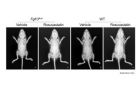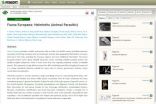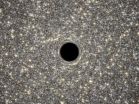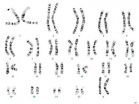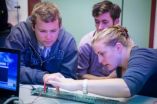(Press-News.org) Skeletal dysplasia is a group of rare diseases that afflict skeletal growth through abnormalities in bone and cartilage. Its onset hits at the fetal stage and is caused by genetic mutations. A mutation in the gene encoding fibroblast growth factor receptor 3 (FGFR3) has been associated with two types of skeletal dysplasia, thanatophoric dysplasia (TD), a skeletal dysplasia that cause serious respiratory problems at birth and is often lethal, and achondroplasia (ACH), which causes stunted growth and other complications throughout life. Several experimental treatments have been considered, but none are commercially available.
The need for new drug compounds that can combat skeletal dysplasia has led the Noriyuki Tsumaki group at CiRA, Kyoto University, to consider iPS cell technology. In a joint study with Associate Professor Hideaki Sawai of Hyogo College of Medicine and Team Leader Shiro Ikegawa of RIKEN, Professor Tsumaki's team screened molecules based on their ability to rescue TD-iPSCs from degraded cartilage. Molecules known to affect FGFR3 signaling and/or the metabolism of chondrocytes, the cells responsible for growing cartilage, were identified as good candidates. More importantly, so too were statins, a class of drugs renown for their action against cholesterol and investigated because they have anabolic and protective effects on chondrocytes.
The authors used iPS cells generated from the fibroblasts of both healthy individuals (WT-iPSC) and TD patients (TD-iPSC). Chondrocytes differentiated from TD-iPSC produced less cartilage than those from WT-iPSC and also had a lower proliferation rate and greater apoptosis, properties that were attributed to a gain of function by the mutated FGFR3. Adding statin recovered the cartilage formation in TD-iPSC and increased the proliferation rate. Coincidently, the group observed increased expressions of SOX9, a chondrocytic transcription factor, and of COL2A1 and ACAN, two cartilage extracellular components, all of which are down-regulated in TD patients. Moreover, statin treatment was found to accelerate the degradation of the FGFR3 protein in chondrogenically differentiated TD-iPSC, a process inhibited in TD cases.
Following the success of treating TD in vitro, the investigators then examined whether similar positive effects could be made against ACH. Cultured ACH-iPS cells showed promise, so the team observed statin treatment on transgenic mice that had the FGFR3 mutation and ACH symptoms, including short bones. Sacrifice at 15 days showed that daily intraperitoneal injections of statin into these mice recovered bone length (figure 1). Furthermore, organ cultured cartilage from ACH mice treated with statin resulted in increased expression of the aforementioned three genes and also in Runx2 and Col10a1, which indicated that statin stimulated both the differentiation and maturation of ACH mouse chondrocytes. The authors also discovered that statin stimulated the degradation of FGFR3 in mice by targeting the proteasomal pathway, offering new insight on the mechanism of action.
Because statins have been long used to treat hyperlipidemia and heart disease in adults, there already exists exhaustive information about their appropriate dose and dosage. Therefore, the application of statins to TD and ACH to the clinic should be accelerated relative to normal drug development.
At the same time, Prof. Tsumaki is cautious about these findings, especially with regards to children. "Currently, statins should not be used in children, because statins decrease cholesterol, an essential steroid for the growth and development of children". He adds that further examination is also needed on the appropriate delivery and dose for skeletal dysplasia treatment. "We show that an injection of 1 mg per kg of rosuvastatin into the ACH mouse model restored bone growth in the limbs and head. However, this dose would translate into 70 mg per day for a 70 kg human, which far exceeds the 20 mg limit in Japan and 40 mg limit in Europe and the U.S".
"Because statins are used primarily in adults, there is a paucity of data for child and infant patients. Therefore, much more study on the efficacy and safety of statins, especially in the young, is needed before they reach the clinical stage for TD and ACH treatment".
CiRA Director and Professor Shinya Yamanaka, the pioneer of iPSC technology commented; "This study is an important research result, as it demonstrates that patient-specific iPSCs can be an effective tool for drug repositioning. I hope this approach will be a model to help us find new cures for other intractable disease".
INFORMATION:
Details about the article
Title: Statin treatment rescues FGFR3 skeletal dysplasia phenotypes
Journal: Nature
Authors: Akihiro Yamashita, Miho Morioka, Hiromi Kishi, Takeshi Kimura, Yasuhito Yahara, Minoru Okada, Kaori Fujita, Hideaki Sawai, Shiro Ikegawa and Noriyuki Tsumaki
Researchers use iPS cells to show statin effects on diseased bone
Researchers at CiRA in Kyoto find the injection of statin promotes bone growth in mice with achondroplasia symptoms
2014-09-17
ELSE PRESS RELEASES FROM THIS DATE:
Math model designed to replace invasive kidney biopsy for lupus patients
2014-09-17
COLUMBUS, Ohio – Mathematics might be able to reduce the need for invasive biopsies in patients suffering kidney damage related to the autoimmune disease lupus.
In a new study, researchers developed a math model that can predict the progression from nephritis – kidney inflammation – to interstitial fibrosis, scarring in the kidney that current treatments cannot reverse. A kidney biopsy is the only existing way to reach a definitive diagnosis of the damage and its extent.
The model could also be used to monitor the effectiveness of experimental treatments for inflammation ...
Large study reveals new genetic variants that raise risk for prostate cancer
2014-09-17
In an analysis of genetic information among more than 87,000 men, a global team of scientists says it has found 23 new genetic variants – common differences in the genetic code -- that increase a man's risk for prostate cancer. The so-called "meta-analysis," believed to be the largest of its kind, has revealed once hidden mutations among men in a broad array of ethnic groups comprising men of European, African, Japanese and Latino ancestry.
The meta-analysis combined information from smaller studies, according to William B. Isaacs, Ph.D., a genetic scientist at the Brady ...
Babies learn words differently as they age, researcher finds
2014-09-17
COLUMBIA, Mo. – Research has shown that most 18-month-olds learn an average of two to five new words a day; however, little is known about how children process information to learn new words as they move through the preschool years. In a new study, a University of Missouri researcher has found that toddlers learn words differently as they age, and a limit exists as to how many words they can learn each day. These findings could help parents enhance their children's vocabularies and assist speech-language professionals in developing and refining interventions to help children ...
Contributions on Fauna Europaea: Data papers as innovative model on expert involvement
2014-09-17
Fauna Europaea started in 2000 as an EC-FP5 four-year project, delivering its first release in 2004. After 14 years of steady progress and successful participations in several EC projects, as a part of the EC-FP7 European Biodiversity Observation Network project (EU BON), to increase the general awareness of the work done by the contributors and to extend the general dissemination of the Fauna Europaea results, the Biodiversity Data Journal has applied its novel e-Publishing tools to prepare data papers for all 56 major taxonomic groups.
Fauna Europaea provides a public ...
Big surprises can come in small packages
2014-09-17
Astronomers using the NASA/ESA Hubble Space Telescope have found a monster lurking in a very unlikely place. New observations of the ultracompact dwarf galaxy M60-UCD1 have revealed a supermassive black hole at its heart, making this tiny galaxy the smallest ever found to host a supermassive black hole. This suggests that there may be many more supermassive black holes that we have missed, and tells us more about the formation of these incredibly dense galaxies. The results will be published in the journal Nature on 18 September 2014.
Lying about 50 million light-years ...
A link between Jacobsen syndrome and autism
2014-09-17
SAN DIEGO, Calif. (Sept. 17, 2014)— A rare genetic disorder known as Jacobsen syndrome has been linked with autism, according to a recent joint investigation by researchers at San Diego State University and the University of California, San Diego. In addition to suggesting better treatment options for people with Jacobsen syndrome, the finding also offers more clues into the genetic underpinnings of autism.
Jacobsen syndrome affects approximately 1 in 100,000 people, according to the National Institutes of Health. It occurs in a person when there is a deletion at the end ...
Lack of facial expression leads to perceptions of unhappiness, new OSU research shows
2014-09-17
CORVALLIS, Ore. – People with facial paralysis are perceived as being less happy simply because they can't communicate in the universal language of facial expression, a new study from an Oregon State University psychology professor shows.
The findings highlight the important role the face plays in everyday communication and indicates people may hold a prejudice against those with facial paralysis because of their disability, said Kathleen Bogart, an assistant professor of psychology in the College of Liberal Arts at Oregon State University.
"People are more wary and ...
Entrepreneurs aren't overconfident gamblers
2014-09-17
Leaving one's job to become an entrepreneur is inarguably risky. But it may not be the fear of risk that makes entrepreneurs more determined to succeed. A new study finds entrepreneurs are also concerned about what they might lose in the transition from steady employment to startup.
In Entrepreneurship and Loss-Aversion in a Winner-Take-All Society, Professor John Morgan at UC Berkeley's Haas School of Business and co-author Dana Sisak, assistant professor at the Erasmus University Rotterdam, focused on the powerful impact of loss aversion.
Loss aversion, or the fear ...
Oxides discovered by CCNY team could advance memory devices
2014-09-17
The quest for the ultimate memory device for computing may have just taken an encouraging step forward. Researchers at The City College of New York led by chemist Stephen O'Brien have discovered new complex oxides that exhibit both magnetic and ferroelectric properties.
Combining both properties is very exciting scientifically for the coupling that can occur between them and for the devices that might ultimately be designed, in logic circuits or spintronics. Combining these two properties in a single material, however, has proved difficult until now.
Using an innovative ...
Engineers develop algorithms to switch out and recharge battery modules in electric cars
2014-09-17
Imagine being able to switch out the batteries in electric cars just like you switch out batteries in a photo camera or flashlight. A team of engineers at the University of California, San Diego, are trying to accomplish just that, in partnership with a local San Diego engineering company.
They have developed smaller units within the battery, called modules, and a battery management system that will allow them to swap out and recharge the modules, rather than swapping out the whole battery, which is cumbersome and requires large, heavy equipment. They recently presented ...
LAST 30 PRESS RELEASES:
NTP-enhanced lattice oxygen activation in Ce-Co catalysts for low-temperature soot combustion
Synergistic interface engineering in Cu-Zn-Ce catalysts for efficient CO2 hydrogenation to methanol
COVID-19 leaves a lasting mark on the human brain
Scientists use ultrasound to soften and treat cancer tumors without damaging healthy tissue
Community swimming program for Black youth boosts skills, sense of belonging, study finds
Specific depressive symptoms in midlife linked to increased dementia risk
An ‘illuminating’ design sheds light on cholesterol
Who is more likely to get long COVID?
Study showcases resilience and rapid growth of “living rocks”
Naval Research Lab diver earns Office of Naval Research 2025 Sailor of the Year
New Mayo-led study establishes practical definition for rapidly progressive dementia
Fossil fuel industry’s “climate false solutions” reinforce its power and aggravate environmental injustice
Researchers reveal bias in a widely used measure of algorithm performance
Alcohol causes cancer. A study from IOCB Prague confirms damage to DNA and shows how cells defend against it
Hidden viruses in wastewater treatment may shape public health risks, study finds
Unlock the power of nature: how biomass can transform climate mitigation
Biochar reshapes hidden soil microbes that capture carbon dioxide in farmland
Reducing saturated fat intake shows mortality benefit, but only in high-risk individuals
Manta rays create mobile ecosystems, study finds
Study: Mixed results in using lipoic acid to treat progressive multiple sclerosis
Norbert Holtkamp appointed director of Fermi National Accelerator Laboratory
New agentic AI platform accelerates advanced optics design
Biologists discover neurons use physical signals — not electricity — to stabilize communication
Researchers discover that a hormone can access the brain by hitchhiking
University of Oklahoma researcher awarded funding to pursue AI-powered material design
Exploring how the visual system recovers following injury
Support for parents with infants at pediatric check-ups leads to better reading and math skills in elementary school
Kids’ behavioral health is a growing share of family health costs
Day & night: Cancer disrupts the brain’s natural rhythm
COVID-19 vaccination significantly reduces risk to pregnant women and baby
[Press-News.org] Researchers use iPS cells to show statin effects on diseased boneResearchers at CiRA in Kyoto find the injection of statin promotes bone growth in mice with achondroplasia symptoms
